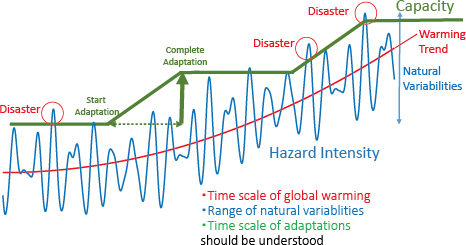How will global warming affect typhoons, floods, sediment disasters, and river flows? Theme D aims to project how devastating these disasters will change over the next 100 years and scientifically reveals the relationship between global warming and disasters. Mainly the following two analysis methods will be adopted: the first one is to quantify the probability of climate change impact on typhoons and flooding etc. and the second one is to assess the impact of climate change with the worst case scenarios that consider extraordinary situations such as super typhoons. In recent years, Japan as well as other countries have been affected by frequent and unprecedented disasters. Potential damages by such record-breaking disasters enhanced by climate change should be assessed from scientific and engineering perspectives. Moreover, we hope to provide basic information on appropriate measures needed in the future by understanding also the economic impacts.
By conducting integrated hazards assessment, Theme D will analyze future changes of hazards and their social impacts in order to provide essential information and the necessary methods for use in preparing no-regret adaptation measures. We therefore intend to take into account what we need to consider and prepare for use in no-regret and proactive adaptation strategies by increasing the sophistication, integration, and depth of hazard models. In addition, we will establish the foundation for the necessary adaptation in other Asian countries as well as in Japan. We have been working on “the future changes of design external forces and the estimation of largest-class external forces” through KAKUSHIN, SOUSEI and this TOUGOU program up until now, which will be used to proceed with “the impact assessment on meteorological disasters, water-related disasters, coast disasters and risks” from a new and integrated point of view.
| Subject | Representative |
|---|---|
| (ⅰ)Long-term assessment of intensity and frequency of extreme hazards | Nobuhito Mori Disaster Prevention Research Institute, Kyoto University, Associate Professor |
| (ⅱ)Seamless hazard prediction until the end of the 21st century | Kenji Tanaka Disaster Prevention Research Institute, Kyoto University, Associate Professor |
| (ⅲ)Hazard analysis of past disasters and assessment of climate change factors | Tetsuya Takemi Disaster Prevention Research Institute, Kyoto University, Associate Professor |
| (ⅳ)Hazard assessment in Asian and Pacific countries and international cooperation | Yasuto Tachikawa Graduate School of Engineering, Kyoto University, Professor |
| (ⅴ)No-regret adaptation strategies with consideration for various changes | Hirokazu Tatano Disaster Prevention Research Institute, Kyoto University, Professor |
| (ⅵ)Development of bias correction methods and extreme values assessment technology | Toshikazu Kitano Department of Civil Engineering, Nagoya Institute of Technology, Professor |


